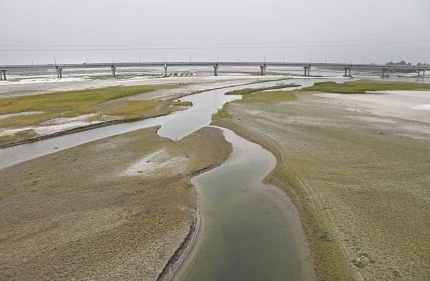The joy of people in northern Bangladesh due to a sudden rise in the Teesta water flow from 830 cusecs (cubic feet per second) to 3,050 cusecs within 24 hours earlier this week was short-lived. The flow went down to 1,243 cusecs the next day.
In this early summer heat, with temperatures already touching 40 degrees Celsius, the transboundary river Teesta – flowing from India to Bangladesh – is back to being almost dry. There had been joy when Indian authorities released water from a barrage upstream, but the barrage gates were shut within 24 hours.
Despite strenuous efforts by diplomats in both countries, India and Bangladesh are yet to reach to an agreement on Teesta water sharing. The two governments had finalized an agreement, and were set to sign it during the September 2011 visit to Dhaka by India’s Prime Minister Manmohan Singh. But the signing had to be cancelled following last-minute objections from Mamata Banerjee, chief minister of the Indian state of West Bengal, through which the Teesta flows before reaching Bangladesh.
See also: Teesta river runs dry as India and Bangladesh fail to resolve water disputes
Talking about the sudden increase in water flow for a day, Mir Sazzad Hossain, a Bangladeshi government representative in the India-Bangladesh Joint River Commission, said, “When there is no rain, sudden rise in Teesta water flow means Indian authorities have opened the sluice gates of their Gajoldoba barrage.”
Asked why the water flow went down to 1,243 cusecs by mid-week, Hossain said he had no explanation.
The fourfold rise in the water flow on Tuesday April 22 astonished engineers at the Teesta Barrage Authority. But by noon the next day, the water flow at Lalmonirhat – the Bangladesh part of the irrigation barrage – went down to 1,242 cusecs from 3,050 cusecs at 6:50 p.m. on Tuesday. The water flow started decreasing around 11 p.m. on Tuesday, said an official of the barrage authority.
Mahbubur Rahman, an executive engineer of the barrage authority posted near the spot at Daliya, said, “India released some water to Bangladesh suddenly on Tuesday. It may have been due to a technical problem on the Indian side at Gajoldoba barrage.”
“We didn’t get any message from the Indian authorities at Gajoldoba about the sudden release of water. Maybe they closed the gates after solving their technical problem.”
Before the increase on Tuesday, the flow was 830 cusecs on Monday, 789 on Sunday and 688 on Saturday. The irrigation project in Bangladesh needs around 4,500 cusecs to be fully operational.
Farmers downstream – especially those sowing their crops on the river’s floodplains during this lean season – are worried that they will not get the expected output due to lack of water.
Some locals say the water flow on Wednesday appeared less than the official figure of 1,242 cusecs. Faridul Islam Feroze – president of the Teesta Bachao Andolon, a people’s platform to save the river said, “I find the water level is the same as it was during the 700 cusecs when I visited the Teesta barrage point a few days ago.”
The water flow in the Teesta in Bangladesh has been ranging between 416 cusecs and 830 cusecs since February. Most of the riverbed is dry, and there is very little water for farmers along the riverbanks. Various NGOs – including Teesta Bachao Andolon – and political parties have been taking out rallies, processions, marches and forming human chains for the last two months, demanding that Bangladesh gets a larger share of the river’s water.
The country’s main opposition Bangladesh Nationalist Party (BNP) also launched a two-day march towards the Teesta barrage, which ended on Wednesday. In the concluding rally at Dalia, just adjacent to the Teesta barrage, Fakhrul Islam Alamgir – who led the march – warned that bilateral ties with India would deteriorate, if the upstream country did not release “due share of water of all common rivers.”
“Our relationship with them (India) will be developed, if they gives us due share of water. Otherwise our relation will be soured,” said Alamgir, who is the acting general secretary of the BNP. He claimed that India should release around 10,000 cusecs in the Teesta to meet the demand of people in northern Bangladesh.
Hydrologists in West Bengal have been saying the river has nowhere near that volume of water in the lean season, as the flow is being impacted by a series of hydropower projects further upstream in the Indian state of Sikkim.
Asked about the state of talks between India and Bangladesh on the Teesta agreement, Anisul Islam Mahmud, Water Resources Minister of Bangladesh, said the issue is under negotiation. If Bangladesh fails to seal a deal with India, it will raise the issue at an international tribunal, he added.
That will be difficult, especially since neither country has signed the 1997 UN convention on the non-navigable uses of international watercourses. The people downstream remain thirsty.

